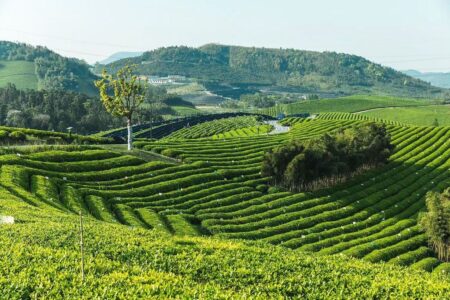The Value of Transparency

Parts one and two of this series (March and April 2017 issues, respectively) addressed how direct trade transactions, traceability, and transparency all add different values to the supply chain for different types of coffee buyers. The final part of this series, a special online feature, explores how transparent traceability can begin at origin and include new participants in the coffee commercialisation process through new tools like digital platforms.
By Rachel Northrop
Transparency Invites Broader Participation
The greater the transparency of a supply chain, the more it invites participation from different parties. Exporter Cafcom in Guatemala City identifies constant communication as key to traceability. Elizabeth Potanza is a trader specialising in microlots and is one of many people responsible for ensuring traceability. “It all starts when a producer assigns a code for a specific lot and harvest day. This code is kept during the washing process and also during the drying period,” she said, adding that the code also contains information such as date, lot being harvested, variety, arriving time to wet mill, period of fermentation, date of washing, patio and/or drying entries, duration of drying process, and date this coffee is delivered to the dry mill.” For a transparent record of coffee’s movement and provenance to be available later, there must be sufficient teamwork to keep the right records at the most complicated logistic points.
Documents like receipt numbers make traceability verifiable, important because each direct coffee transaction follows a different path, which can be confusing to conceptualise.
The information on coffee package labeling and retail signage is a static snapshot of select information about a coffee. One of the biggest challenges of transparently communicating the value of direct trade is that, while the terminology “direct” implies simplification, all coffee trade is still complex; direct trade just involves different parties making different decisions at different points to influence which coffees ultimately arrive in a consuming country. To be transparent about the nuances of direct trade is difficult to do concisely because there are actually more people involved with each other at a given time than in a traditional supply chain.
“We try our best to be open and honest about how far down the supply chain we can actually have traceability and can be in control,” said Morten Wennersgaard, product manager and founder of Nordic Approach specialty importers in Oslo, Norway. “That is why I like transparency as a better term than traceability. There are many different structures, and sometimes it is hard for everyone to fully understand how it works. We are also bringing clients to producing countries to better communicate how the process of sourcing coffee,” reiterating one of the new roles of an importer as origin host.
Digital media can be updated in real time to reflect these complicated structures and provides the space to elucidate the complex path a coffee travels from farm to cup. “It’s like an open book policy,” continued Wennersgaard. “Customers are welcome to get documentation [from Nordic Approach] on everything from our purchase prices to the breakdown of costs as far as we can. This information is available through info sheets, projects described in blog posts, and social media.” By using digital platforms to document all aspects of direct trade, transparency invites a wider participation from consumers, clients and other industry members.
Transparency encourages dialogue that accelerates improvements and innovation when presented as an open forum. Transparent traceability requires the kind of detailed record keeping Potanza described, and while keeping more records involves more work, it adds the value of including more people in the process of buying and selling coffee. For many buyers, the ability to participate and have a voice in the sourcing process and being able to see investment projects at origin develop during the months they are not visiting is an important value added by transparent direct trade sourcing.
Starting at Origin
Transparency is a valuable tool for keeping track of coffee as it moves across borders, but it is also invaluable when used informally in the coffee consuming cultures developing in producing countries.
In Kigali, Rwanda, Question Coffee is a roaster, café, and coffee training lab serving coffee grown by women smallholders in Rwanda’s coffee mountains run in conjunction with Sustainable Harvest importers from Portland, Oregon. Dan Sibomana is a roaster and barista with Question Coffee. He spoke to Tea & Coffee Trade Journal after one of Question Coffee’s regular barista events. “Customers come to Question Coffee because they know we work directly with women coffee farmers, and they know that any cup consumed is a great contribution to women’s hardworking efforts to make the most of specialty coffee.” In Rwanda, as a coffee-producing country with only one place to buy freshly roasted coffee beans, transparency and traceability can involve technical record keeping, but they can also be as informal as a barista naming the regional source of the beans. This information will be immediately meaningful because the farms are hours, rather than continents, away.
“Our customers also trust our baristas,” Simbomana noted, “because they are all able to answer any questions regards the coffee we serve.” In a coffee producing country, transparency adds the value of local pride, of offering the best possible quality to the people closest to the source. At origin, the added value of transparency is in supporting a local economy, particularly one that advocates for struggling demographics, such as women in rural communities. Simbomana observed that both locals and foreign café guests know that it is no small feat “that Sustainable Harvest has gathered over 4,000 women in two cooperatives, and their hard work has positively changed their lives and the community.”
Transparency, the New Trust?
Transparency in more traditional coffee supply chains and in new direct trade supply webs, links producers, intermediaries and buyers, adds values related to ethics, reliable quality, regional differentiation, personal connection, and producer profit viability. However, the demand for and delivery of transparency creates a difficult paradox: transparency adds value to direct trade by honestly reporting traceability, revealing the degree to which information is comprehensive or lacking.
True transparency means that, in some cases, the information that is transparently shared might not tell the whole story, and there might not be a way to verify certain parts of the chain. Where transparency leaves off, trust must take over. Traceability relies heavily on detailed, timely, and accurate documentation. Sometimes, due to the variable nature of agriculture and other factors, the correct information is not recorded at the necessary moment, and the chain of traceability is incomplete. Transparency reveals these imperfections.
Direct trade defines itself through its foundation in the relationships between suppliers, distributors, and buyers, and transparency puts this trust to the test. Interpreting any incomplete information revealed by transparency as negative challenges the foundation of trust that underlies direct trade. In a traditional supply chain, each party needs only to trust the information and product provided by the party one link upstream. Because transparent direct trade puts all actors of the supply web in conversation, that trust must extend wherever transparency is offered. The greatest value of direct trade’s transparency is not that is replaces trust, but that it furthers it. When different parties better understand each other’s roles, then transparency means that problems can be addressed collectively and solutions be drafted together.
Rachel Northrop has been covering coffee from the ground up for Tea & Coffee Trade Journal and other industry publications since 2012, while she lived in Latin America’s coffee lands writing When Coffee Speaks. She is based in Brooklyn, NY. She may be reached at [email protected].



